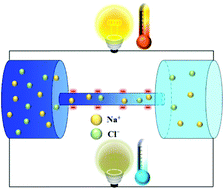Salinity gradient power: influences of temperature and nanopore size
Abstract
Salinity gradient power is a promising, challenging, and readily available renewable energy. Among various methods for harvesting this clean energy, nanofluidic reverse electrodialysis (NRED) is of great potential. Since ionic transport depends highly on the temperature, so is the efficiency of the associated power generated. Here, we conduct a theoretical analysis on the influences of temperature and nanopore size on NRED, focusing on the temperature and nanopore size. The results gathered reveal that the maximum power increases with increasing temperature, but the conversion efficiency depends weakly on temperature. In general, the smaller the nanopore radius or the longer the nanopore, the better the ion selectivity. These results provide desirable and necessary information for improving the performance of NRED as well as designing relevant units in renewable energy plants.


 Please wait while we load your content...
Please wait while we load your content...